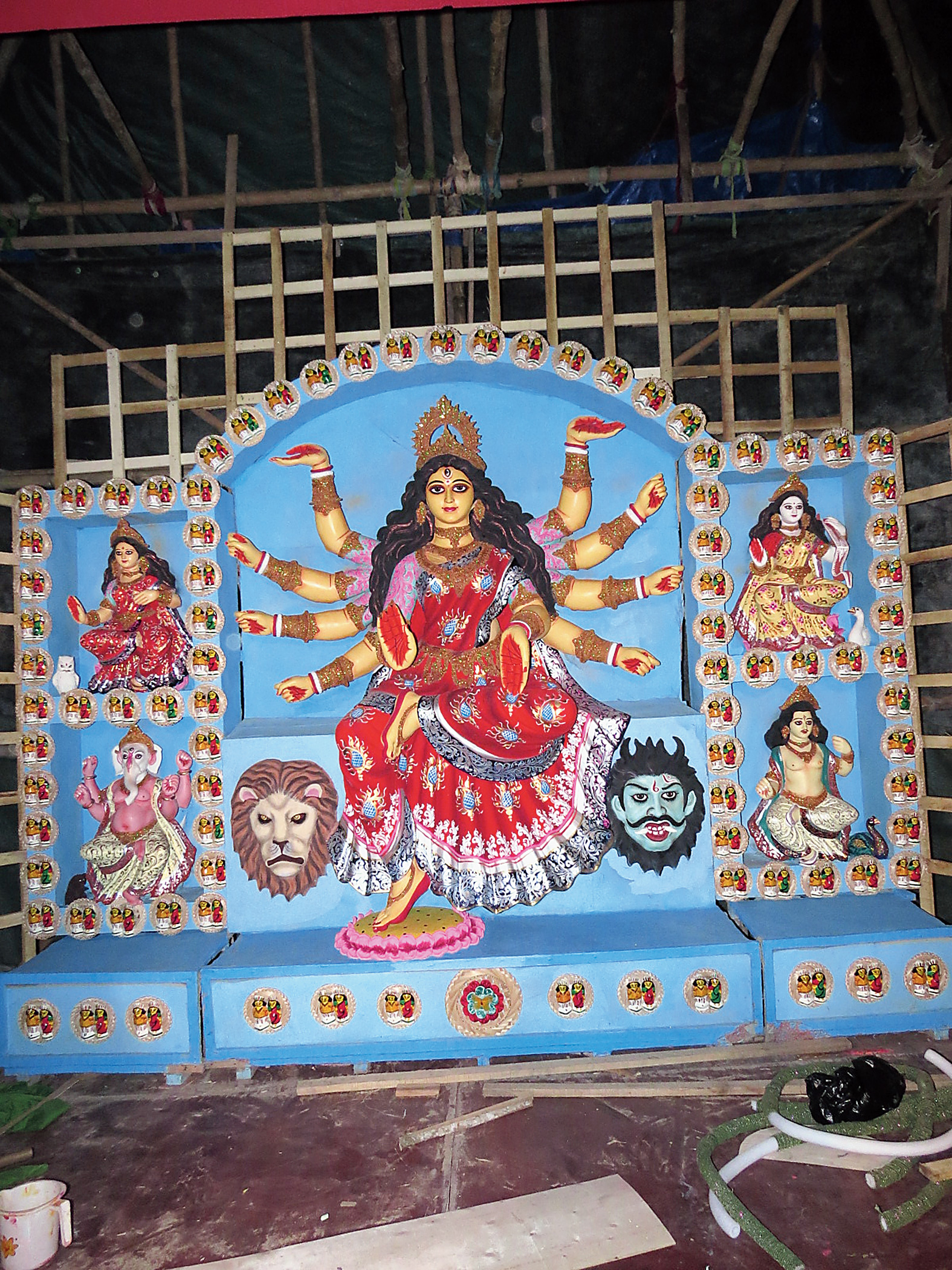
Notun Palli Pradeep Sangha Sudeshna Banerjee
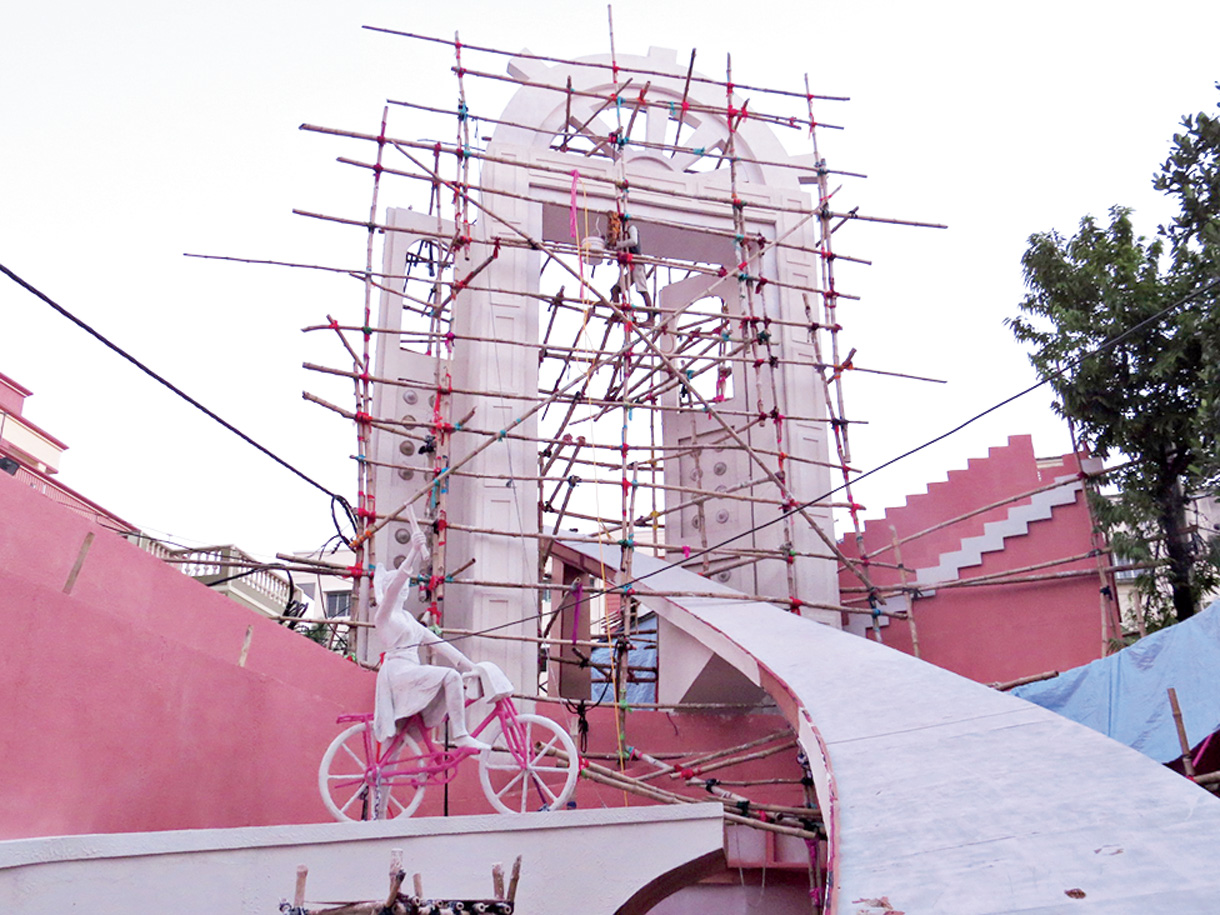
Bharat Chakra Sudeshna Banerjee

DUM DUM TARUN DAL Sudeshna Banerjee
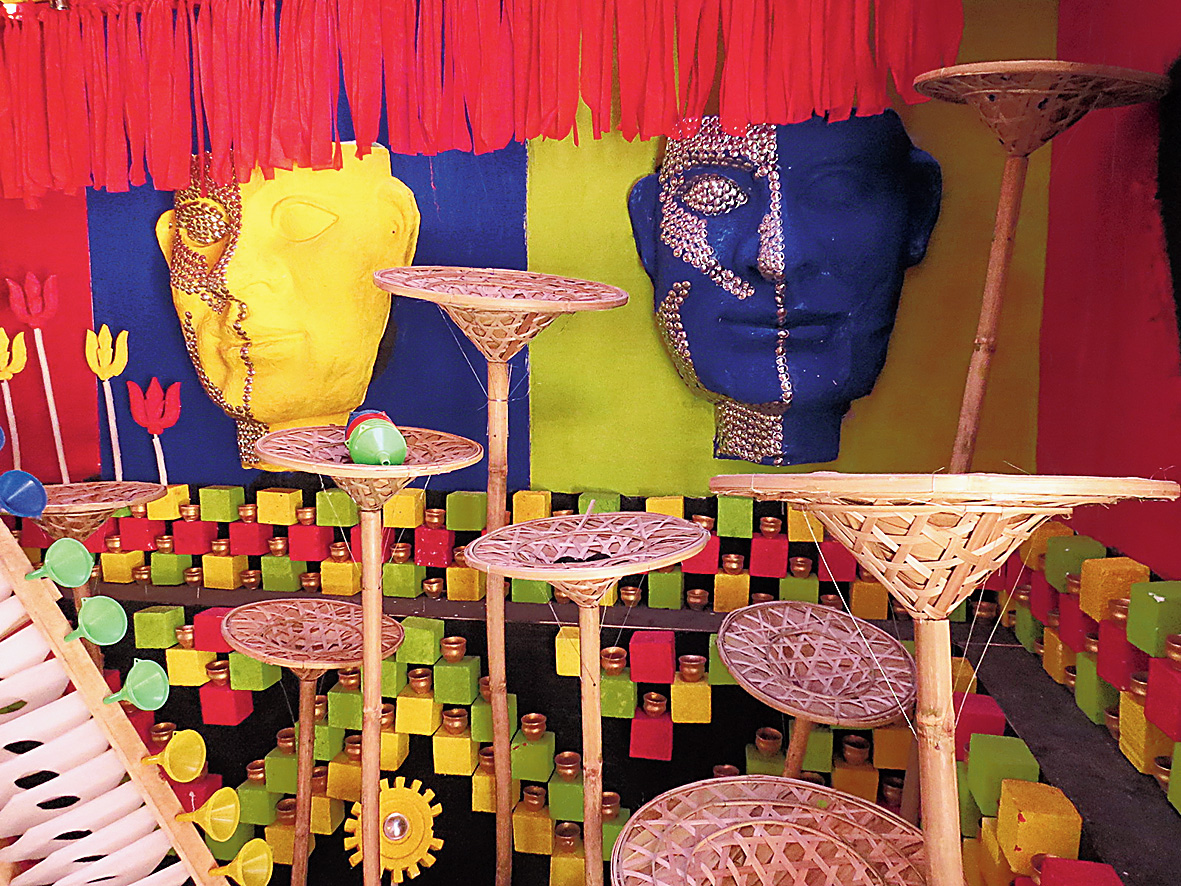
NABAMILAN Sudeshna Banerjee

PALLYSHREE Sudeshna Banerjee
Telengabagan
Year: 53rd
Budget: Rs 20 lakh
Theme: Alor pathajatri
The look: It’s a grim ambience. The walls of the most part of the pandal have moss-covered exposed bricks painted on them. There are sections jutting out in places which have hands gripping wooden grilles from inside. At a side, a courtroom has been created, with a witness box. From the roof hang ropes with knots. These are the hangman’s ropes, but the noose has been cut off.
Organiserspeak: “With the country getting torn asunder by communal tension and caste considerations, we are invoking the freedom fighters who selflessly gave their lives but whose sacrifices are forgotten,” said an organiser. The artistes here are Partha Ghosh and Siddhartha Ghosh.

SANGRAMI Sudeshna Banerjee

MITALI Sudeshna Banerjee

Beleghata 33 PALLI Sudeshna Banerjee

SREEBHUMI Sudeshna Banerjee
Netaji Sporting Club
Year: 39th
Budget: Rs 12 lakh
Theme: Banglar natok katha
The look: The pandal is dedicated to theatre. A ticket counter stands outside. The figures of the gods and their mounts will be created on the facade with collages of stills of plays and posters. On the two sides there will be two huge masks made of mirrors — one smiling and one sad. The pandal interior is treated as an auditorium, with rows of seats as galleries. On the walls hang various props — items of clothing, wig, revolver, mirror etc. Other articles like chairs and ladders will hang overhead. The chandelier will be formed of microphones, tridents and loudspeakers. On the stage a play is in progress and the idol as if holds position in course of the act.
Artistespeak: “The popularity of theatre is dwindling. We want to remind people of theatre as a form of entertainment,” say the theme-maker duo Gargee Ghosh, a ceramic artiste, and Sayoni Niyogi, a painter.

SANDHANI Sudeshna Banerjee
Ultadanga area
Tarun Sangha
Year: 33rd
Budget: Rs 34 lakh
Theme: Stop Gansha 24x7
The look: The pandal brilliantly executes a powerful idea — of child labour. The story is of an orphaned boy working at a tea stall called Gansha. As one enters, one sees inside a child’s hollow head, about 20ft high, where on the inner surface a child — Gansha himself — runs amid catkins under a blue autumn sky. About 20 radio sets hang, with the Mahishasuramardini programme playing in the background. That is Gansha’s dream. The pandal is his reality. The walls are covered with about nine lakh tea bags, with Gansha’s name printed on the tag. Overhead, thick Cutting Chai glasses, used in tea shops, hang from wire holders. The colourful tiny lights inside each of them create an amazing effect. In places, kettles hang with Gansha’s name on them. The Mother Goddess is seated on a throne adorned with the nozzles of kettles. In front of her sits Gansha. He may be in his soiled sando ganji, but he thinks himself a part of the divine retinue, replacing Ganesh, wearing an elephant’s trunk and a crown made of cigarette foil.
In a torture chamber on the way out is Gansha’s daily life. Twelve feet long kitchen tongs bear down on him from the ceiling as the grimy walls scream with graffiti — stop, mukti chai, thamao etc. The sides of the walls are lined with huge nails. The exit leads to a ghat where immersion is taking place of a small idol. But it’s actually Gansha himself with 10 hands seeking release. Grasshoppers and winged kettles fly in the sky over the water, signalling the end of his bondage.
Artistespeak: “I thought of the idea on seeing a boy called Patla who I sometimes chatted with in a tea stall elsewhere. The club has also invited a tea stall boy on the day of the inauguration. I plan to leave the clay idol unpainted. No mother can be happy seeing the plight of a son,” says Rintu Das.
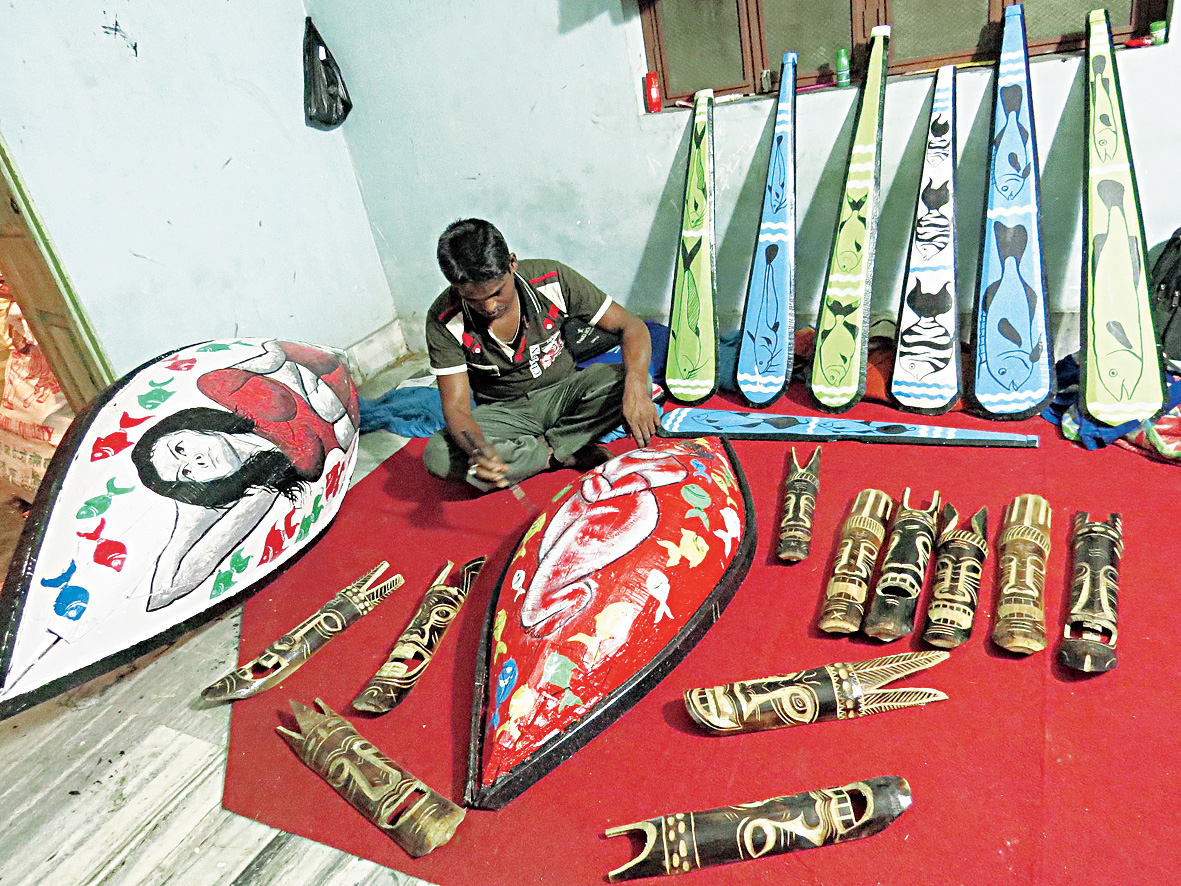
Dum Dum Park Sarbojanin Sudeshna Banerjee

LAKE TOWN ADHIBASIBRINDA Sudeshna Banerjee

Dum Dum Park Yubakbrinda Sudeshna Banerjee
Kankurgachhi-Beleghata area
Mitali
Year: 82nd
Theme: Bimurter araley
The look: The pandal is all about play with form and colours. Materials of daily use like pipe, string, paper, cloth have been used to create abstract forms which do not conform to any geometric shape. The colours are not flat and create a magical effect when the concealed lights are turned on. Two cycles have been used outside as installations.
Artistespeak: “The viewer is free to interpret what he sees,” says Kartik Pal.

LAKE TOWN ADHIBASIBRINDA Sudeshna Banerjee
Sandhani
Year: 49th
Budget: Rs 35 lakh
Theme: Tarjon gorjon
The look: Skyscrapers in black make up the upper walls of the pandal, depicting increasing urbanisation. Paw marks of tigers, lit up by concealed lights, dot the walls of the sanctum sanctorum. Twigs pasted in the shape of trees make up the chalchitra behind the goddess. The tigers are shows as human figures sporting tiger body paint. They are pulikkali dancers from Kerala. Two such figures hang from the chandelier on the ceiling, hands outstretched towards a baby tiger under threat below. Durga will be worshipped in an angry rudrani form.
Organiserspeak: “The tiger population is decreasing due to rapid urbanisation and deforestation. Our message is to save the tiger,” said Supratim Kar.
Sangrami
Year: 56th
Budget: Rs 15 lakh
Theme: Antarjaley mukti
The look: As one approaches, the outlines of a cityscape presents itself on semi-transparent cloth at a side. Unreal trees, leafless and gleaming with colours other than green, branch out forming an arch above the entrance. In the ground where the pandal stands, men of all four ages are shown sickly and bandaged, but with headphones on. The sky above is crowded with a gigantic web of colourful nylon strings. Five human figures, of fibre, climb the pandal from different sides with dish antennae on their head. At the top of the pandal, two gigantic hands juggle with five globes.
The web motif continues inside the pandal. Each of the idols stands with a separate circular backdrop, as if cut off from each other.
Artistespeak: “We are living a meaningless life, digitally connected but disconnected from each other on the individual level. The internet is being shown as webs of tapestry that two artistes are weaving in all sizes over the last month and half,” said Swarup Nandy.
Dum Dum Park area
Dum Dum Park Yubakbrinda
Year: 52nd
Budget: Rs 20 lakh
Theme: Ma go tomay rakhbo kemon kore?
The look: Numerous ladders stand inclined against the gate with snakes, made of colourful foam pipes, wrapped around them. The pandal brings into focus the position of women in society shown through the highs and lows of a snakes and ladders game. Inside, a giant die stands. On each face of the cube, other than the dots snakes abound. On one side against the wall, a 9ft face of a woman stands with a side scarred. She is an acid attack victim. Other forms of violence are shown symbolically — a human size lipstick broken at the neck and with the tip resembling a woman’s face, a nail polish spilling blood etc. with two predator-like hands as its lid. On the opposite wall, a woman has her anchal flying on both sides like wings but she is tied to her spot by snakes. Four girls pray before Durga in the sanctum sanctorum.
Artistespeak: “The snake ladder game was evolved to impart to children a lesson. The 100th box is release or moksha. Before that life is full of ups and downs, with the downfalls brought about by temptations shown as snakes. Here we show how women’s condition improves where positive forces are on the upswing in society and how things take a downslide when negative forces get the upper hand,” says Debashis Sarkar.
Notun Palli Pradeep Sangha
Year: 38th
Budget: Rs 15 lakh
Theme: Sajiye niye otit gatha/ elo phire biyer katha
The look: The pandal, with Lord Brahma seated atop, celebrates wedding. Hence the articles of decor are kulo, baran dala, ason etc. A shehnai plays on the mic. There are bride and groom dolls from 10 states of India. At the entry, stands a life-size clay figure of a woman in a red-bordered cream sari, piercing a demon’s chest with a trident. Mini bride-groom figures on bamboo slice kulos dot the chalchitra. The idol is weaponless and her hands are in a mudra of offering blessings.
Artistespeak: “Both Durga puja and weddings are auspicious rituals. So they are a good fit with each other. Since the power of Durga is within every woman, we have shown her using the power to destroy evil,” says Biswajit Chakraborty, assistant to the theme-maker Pradip Parui.
Beleghata 33 Palli
Year: 18th
Budget: Rs 35lakh
Theme: Ishan koney Ishani
The look: The direction ishan stands roughly for the northeast corner. Various measuring instruments to deduce direction and angularity have been used to decorate the pandal. Around 5,000 geometry boxes have already been used and scales and compasses are being pasted on the walls. Orders have been placed for two foot long scales and dividers. Wires as thin as 24 gauge to those of 8 gauge thickness are being bent at various angles. Copper sheets as thin as paper is being cut in various formations. A gigantic compass has been drawn on the roof from where the chandelier will hang. Efforts are on to set up a compass outside on either side of the entrance with a sundial in the middle.
Artistespeak: “Ishani is a name for Durga and God is said to occupy the northeast corner. That is why priests face this direction while performing rituals. We human beings also try to find the right direction to reach perfection, i.e. realise God. Our puja itself is also situated in the northeast part of the city,” said Biswanath Dey.
Bharat Chakra
Year: 18th
Budget: Rs 30 lakh
Theme: Ghare o baire
The look: A huge ramp slides skywards. At its base is an auto rickshaw with little pink wings driven by a lady. As one walks in, one sees over the entrance a girl on a cycle throwing a rolled newspaper. Inside, on panels women are shown to drive trains and planes as also play a variety of sports and winning laurels. In the sanctum sanctorum, there are legends from ancient India like Khana and Gargi as well as goddesses from various civilizations, from Greek to Egyptian. The idol sits inside a Shiva linga, bisected and open at the front.
Organiserspeak: “Women are at the forefront both at home and outdoors. And now men are co-operating to bring out the best in womenfolk,” says secretary Arjun Goon.
Tarun Dal
Year: 41st
Budget: Rs 55 lakh
Theme: Abahon
The look: A bed of sunflowers with children’s faces in them greets visitors. There are figures of dancers dancing. The first section on walking in has black walls, representing a world where imagination is stifled. The main pandal is done up with backlit children’s drawings, which have been printed on a kind of cloth that had been supplied to drawing schools. In between the paintings, foam is used to create designs in the quilling style. The next section is all in blue, with babies with eyes closed praying to the mother goddess. The idol will be heavily decorated. The chalchitra will have dolls in various dancing styles. If Bhupen Hazarika’s Aj jibon khuje pabi plays in the background in the first section, in the second and third sections there will be Tagore songs playing - Megher koley rod hesechhey and Esho amar ghorey esho respectively.
Artistespeak: “Today’s children have stunted imagination, playing computer games instead of playing in the fields. If they have scope to give free rein to their imagination, their lives will be transformed,” says Soumen Pal, an assistant of Anirban, the theme-maker.
Dum Dum Park Sarbojanin
Year: 67th
Budget: Rs 20 lakh
Theme: Ujaan thele chollo nao/ Pakhira boley moder pran bnachao
The look: A 100ft long boat is being built by professional boat-makers from Balagarh, Hooghly. Surrounding it is a shallow moat filled with water. The boat has two coverings draped with traditional mats from Sobong as well as three sails, with the mainsail standing at 35ft. Eggshells have been painted and hang with small lamps lit within. Huge cages stand on the sides in which are trapped birds of various feathers, made of wood and clay. Next to them, the pillars are decorated with masks carved out of bamboo from Dinajpur. Even the idols have small birds atop the crowns of each.
Organiserspeak: “The boat, like the ups and downs of life, has to sail in waters both calm and turbulent, often sailing against the tide. Like man, birds too have to lead a life struggling against odds. They are the worst sufferers because of man’s greed and selfish development. Species like titlark and waterfowl have almost become extinct as man preys on them for their flesh. The swallow has to suffer because of mobile towers. We do not wake up to the chirping of a variety of birds anymore,” said Ashok Banerjee, explaining theme-maker Bibhas Mukherjee’s idea.
Nabamilan
Year: 89th
Budget: Rs 9 lakh
Theme: Mrinmoyee mayer taney/ Sajabo jotoney
The look: A gigantic bird with its wings spread sits atop the pandal. Inside, a variety of things, many of them of daily use, like steel spoons, plates, glasses as well as plastic funnels and bamboo hats that farmers wear (toka) are being used to create the bright and colourful pandal interiors. A chandelier made of feathers promises to be an eye-catcher. The artist is Sudip Mondol.
Pallyshree
Year: 70th
Budget: Rs 25 lakh
Theme: Antaheen pran
The look: Jagannath and Krishna sway seated on a mechanised swing at the start of the approach. The trunk of a big tree is being carried towards the pandal. Though the path below rises, being on a raised platform, the trunk is just outside reach. It is meant to carve out the nabakalebar (new form) of Jagannath, whose spirit will have to be infused anew in it. At the end of the platform, on the ground sprigs new leaves from a heap of ashes. Myriad forms that have spirit within, be it a baby or a tree or a sage in meditation, make for the walls on either side of the platform.
Overhead, as one enters the pandal, there are 33ft lampstands hanging through which one gets the first glimpse of the devi.
Organiserspeak: “The cycle of life never ends. Even gods, when they appear on earth as mortals, have to enter this cycle as had happened to Krishna. The Jagannath temple plays out this cycle when they transfuse ‘life’ from one wooden idol to another during nabakalebar,” said the artiste duo Moloy-Subhomoy.
Lake Town area
Sreebhumi
Year: 46th
Budget: Rs 1 crore-plus
The look: The palace of Rana Ratan Singh in Chitor has been recreated with inspiration from the film Padmavat. It stands at a height of 110ft and has elaborate lattice work with jharokha balconies and chhatris, using fibre and thermocol. Inside a mahal has been created, with use of Rajasthan-style painting and mirror work on walls. The idol is grand and imposing, wearing actual gold ornaments. Ganesh is on an elephant and Kartik rides a horse, while their usual mounts — the mouse and the peacock — stand by them. Outside the pandal, two rearing stallions welcome visitors. The chief minister is supposed to visit the pandal today.
Artistespeak: “The film did not show too many indoor scenes so I had to use existing forts and palaces as inspiration,” says Romeo Hazra.

An art work. Sudeshna Banerjee
Lake Town Adhibasibrinda
Year: 56th
Budget: Rs 16 lakh
Theme: Shilpir oi tulir taney swapna jethay dyay dhora/ banglar pran shohor gnaye srishti-krishtir parampara
The look: Three wooden towers on either side line the approach to the pandal. A seventh tower stands at the centre. On its shelves stand representations of the best of Bengal’s traditional craft — dolls from Notungram, Burdwan, terracotta horses from Panchmura, Bankura and patachitra from Pingla, West Midnapore. The walls are lined with mats from Dariyapur, Burdwan, on which hang masks from Chorida, Purulia. An elephant-headed bull stands at the entrance, on which Lord Shiva dances.
The idol has been inspired by the one worshipped in the palace of Cooch Behar. There are no children with Durga. Instead it is Jaya and Bijoya who are flanking her. The demon king at her feet is under attack from both a tiger and a lion.
Organiserspeak: “We visited each of the villages to source the artefacts directly from the craftsmen. Our idol was modelled on the bhabani idol dreamt by king Naranarayan in the 16th century. She is still worshipped as Baradevi there,” says secretary Amitava Basu.
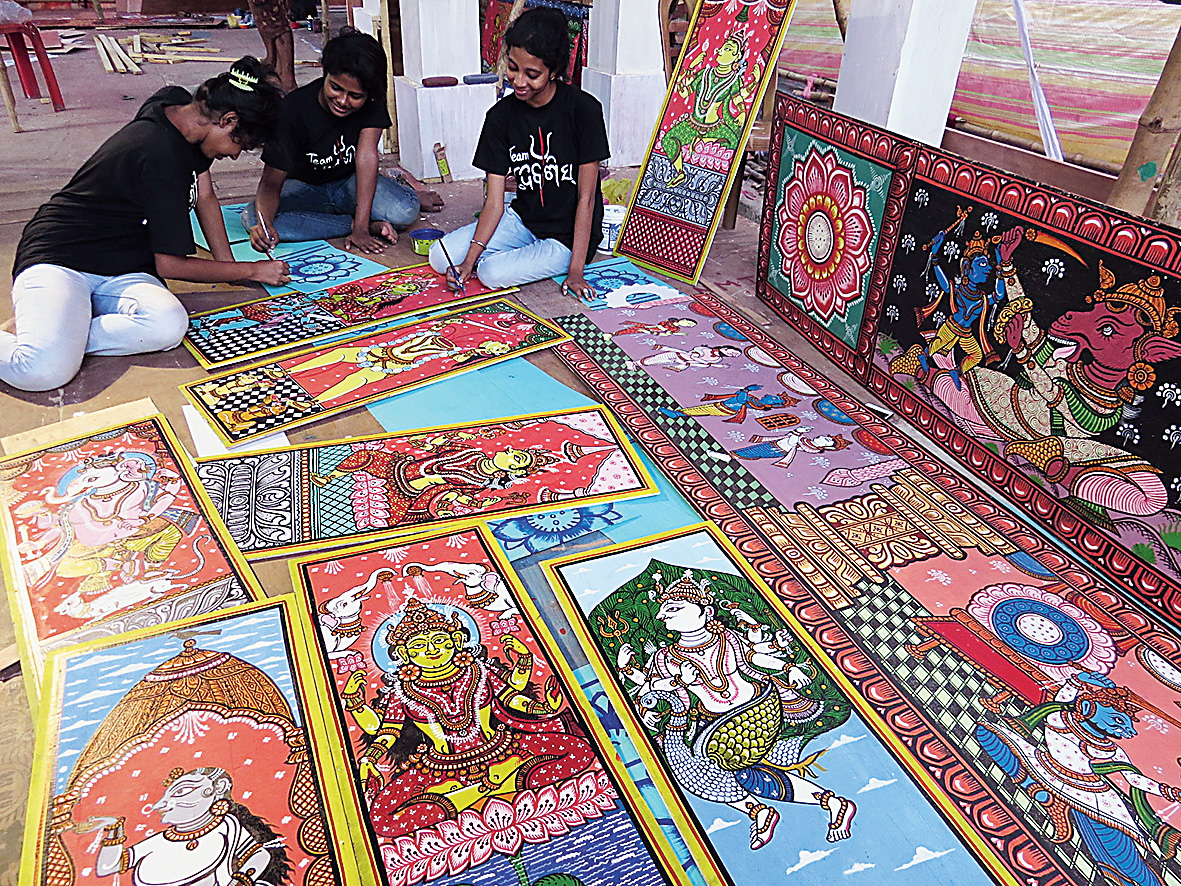
KANKURGACHHI YUBAK BRINDA Sudeshna Banerjee
Kankurgachhi Yubak Brinda
Year: 87th
Budget: Rs 45 lakh
Theme: Gotipua
The look: Walls of houses are being painted at eye level all along the street with paintings related to the culture of Odisha. Two chariots stand on either side of the entrance to the pandal. A team of 26 artistes from the heritage village of Raghurajpur in Odisha is creating beautiful patachitra work on themes like Vishnu’s dashavatara and the mother goddess’s dashamahavidya forms. Some of them will paint seated on either side of the main structure on the puja days.
The goddess will be carved out of mahogany wood and her children hewn out of stone. The ornaments will be of brass and copper.
Artistespeak: “This is our tribute to gotipua which is said to be the root of Odissi dance. Men used to dance dressed as women. It is almost a forgotten art form now,” said Debashis Bhattacharya.










